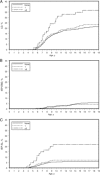Cognitive and behavioral outcomes after early exposure to anesthesia and surgery
- PMID: 21969289
- PMCID: PMC3307194
- DOI: 10.1542/peds.2011-0351
Cognitive and behavioral outcomes after early exposure to anesthesia and surgery
Erratum in
- Pediatrics. 2012 Mar;129(3):595
Abstract
Background: Annually, millions of children are exposed to anesthetic agents that cause apoptotic neurodegeneration in immature animals. To explore the possible significance of these findings in children, we investigated the association between exposure to anesthesia and subsequent (1) learning disabilities (LDs), (2) receipt of an individualized education program for an emotional/behavior disorder (IEP-EBD), and (3) scores of group-administered achievement tests.
Methods: This was a matched cohort study in which children (N = 8548) born between January 1, 1976, and December 31, 1982, in Rochester, Minnesota, were the source of cases and controls. Those exposed to anesthesia (n = 350) before the age of 2 were matched to unexposed controls (n = 700) on the basis of known risk factors for LDs. Multivariable analysis adjusted for the burden of illness, and outcomes including LDs, receipt of an IEP-EBD, and the results of group-administered tests of cognition and achievement were outcomes.
Results: Exposure to multiple, but not single, anesthetic/surgery significantly increased the risk of developing LDs (hazard ratio: 2.12 [95% confidence interval: 1.26-3.54]), even when accounting for health status. A similar pattern was observed for decrements in group-administered tests of achievement and cognition. However, exposure did not affect the rate of children receiving an individualized education program.
Conclusions: Repeated exposure to anesthesia and surgery before the age of 2 was a significant independent risk factor for the later development of LDs but not the need for educational interventions related to emotion/behavior. We cannot exclude the possibility that multiple exposures to anesthesia/surgery at an early age may adversely affect human neurodevelopment with lasting consequence.
Figures
Comment in
-
The pediatrician and anesthesia neurotoxicity.Pediatrics. 2011 Nov;128(5):e1268-70. doi: 10.1542/peds.2011-2489. Epub 2011 Oct 3. Pediatrics. 2011. PMID: 21969291 No abstract available.
References
-
- Wang C, Sadovova N, Fu X, et al. The role of the N-methyl-d-aspartate receptor in ketamine-induced apoptosis in rat forebrain culture. Neuroscience. 2005;132(4):967–977 - PubMed
-
- Slikker W, Jr, Zou X, Hotchkiss CE, et al. Ketamine-induced neuronal cell death in the perinatal rhesus monkey. Toxicol Sci. 2007;98(1):145–158 - PubMed
-
- Wang C, Slikker W., Jr Strategies and experimental models for evaluating anesthetics: effects on the developing nervous system. Anesth Analg. 2008;106(6):1643–1658 - PubMed
Publication types
MeSH terms
Grants and funding
LinkOut - more resources
Full Text Sources
Medical


